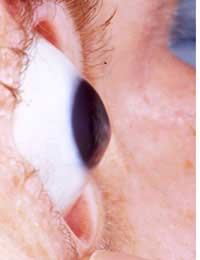Keratoconus

Keratoconus is an eye condition which can cause blurred and distorted sight, as well as a sensitivity to glare and light. The condition affects the cornea which is at the front of the eye. The cornea changes shape and becomes thin and cone shaped. When light enters the eye it is prevented from focusing on the retina because the cornea is the wrong shape. If the light cannot focus on the correct part of the retina then it is difficult to see clearly.
Keratoconus usually affects people in their late teens or twenties and may continue to progress for 10 to 20 years before the condition slows down. It is difficult to detect because it develops slowly over a period of time. The condition may affect each eye differently and can occur in one eye or both. As the keratoconus becomes worse, the cornea bulges more, distorting the vision even further. In some cases the cornea will swell causing sudden and severe sight loss. This swelling occurs when the strain of the cornea’s protruding cone like shape causes a crack. The swelling can last for a number of weeks as the crack heals and is gradually replaced by scar tissue.
Causes
There are a number of possible causes of keratoconus. The condition has been linked to overexposure of sunlight, incorrectly fitted contact lenses, excessive eye rubbing and chronic eye irritation. Recent research has also pointed to a genetic link.Treatment
Eye drops may be prescribed if swelling develops but this only provides temporary relief for the symptoms. There are no medications to stop the condition from developing further.Glasses and contact lenses can be prescribed to treat the short sightedness caused by the keratoconus. Glasses and soft contact lenses will only be of benefit in the early stages of the disease. As the condition becomes more advanced and the cornea becomes thinner and changes shape, glasses or soft contact lenses will not correct eyesight. However, rigid gas permeable contact lenses can be used to correct eyesight but these are more uncomfortable to wear and can be extremely difficult to fit. It is important that the lenses are fitted correctly and it is also necessary to have regular eye checks to ensure they are the correct strength. It can sometimes take several visits to the optician to get the fit and strength of lens absolutely correct.
It may also be possible to have a corneal transplant in some cases when the condition has progressed to a severe level. Even after a transplant, glasses or contact lenses are still often needed for some activities. Before undertaking any surgery or procedure you should always talk through all the risks and any concerns you may have with your eye specialist.
There is also a treatment called Intacs or corneal implants. The implants are inserted just under the eye’s surface in the periphery of the cornea, helping to flatten the cornea back to its normal shape. This is a straightforward procedure and can be carried out in a matter of minutes. As with any procedure there is a risk of infection and afterwards you may experience halo effects or glare.








